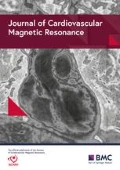Introduction
Recently, higher relaxivity contrasts agents have been advocated for use in infarct imaging. Specifically, MultiHance® (gadobenate dimeglumine) has higher relaxivities (r1 and r2, 9.71 and 12.51) compared to standard Magnevist (gadopentetate dimeglumine) (r1 and r2, 4.91 and 6.31). Will this higher relaxivity show better visualization of subendocardial infarcts or hinder the visualization?
Purpose
We hypothesize that a 0.15 mmol/kg dosage of MultiHance® with its higher relaxivity will produce higher signal intensity in the blood pool cavity compatible with the signal of a subendocardial infarct as compared to a standard 0.20 mmol/kg dosage of Magnevist.
Methods
A total of 42 patients with GFR >60mL/min/1.73 m2 were imaged. Twenty-one (21) patients (17M, 4F), with post-myocardial infarction underwent a standard viability cardiac MRI (CMR) utilizing a total of 0.2mmol/kg gadolinium dosage (Magnevist-Berlex, New Jersey, USA). Twenty-one (21) patients (14M, 7F), with post-myocardial infarction underwent a standard viability cardiac MRI (CMR) utilizing a total of 0.15mmol/kg MultiHance® dosage (Bracco Diagnostics, Princeton, N J, USA). The scans were acquired on a GE CV/i Excite Version 12, 1.5 T system (GE, Milwaukee, WI). The sequence utilized for optimum visualization of the blood pool cavity, nulled myocardium and infarct was a standard 2D Gradient Echo IRP (FGR with inversion recovery prep) and was performed at 10 and 20 min post -contrast administration. The signal intensity (SI) of infarct to left ventricular (LV) blood pool cavity was measured in all 42 patients as well as infarct size.
Results
All patients successfully completed the CMR examination without any difficulty. The signal intensity (SI) of the blood pool cavity, infarct and the ratio between the two was measured at 10 and 20 minute post-contrast. (Table 1)
T-Tests were performed on the ratio between the MultiHance® and Magnevist at 10 (p=ns)and 20 (p<0.5) min post contrast between blood pool cavity and infarct. Quality assurance was performed on all 42 patients for infarct size. (Table 2)
Conclusions
The data shows infarct visualization was best seen at 20 minutes post Magnevist contrast. The ratio between MultiHance® and Magnevist visualization at 20 minutes also demonstrates infarct enhancement better seen at 20 minute post Magnevist. Visually, to the naked eye, both contrast agents showed that a small infarct (2mm) was difficult to discern. Infarct visualization was seen utilizing both contrast agents however with today's economy it would be prudent to utilize Magnevist for infarct imaging and Multihance® where higher relaxivity is needed.
Author information
Authors and Affiliations
Rights and permissions
Open Access This article is published under license to BioMed Central Ltd. This is an Open Access article is distributed under the terms of the Creative Commons Attribution 2.0 International License (https://creativecommons.org/licenses/by/2.0), which permits unrestricted use, distribution, and reproduction in any medium, provided the original work is properly cited.
About this article
Cite this article
Yamrozik, J., Rathi, V.K., Williams, R.B. et al. Can a higher relaxivity contrast agent hinder subendocardial infarct detection in viability imaging?. J Cardiovasc Magn Reson 12 (Suppl 1), T11 (2010). https://doi.org/10.1186/1532-429X-12-S1-T11
Published:
DOI: https://doi.org/10.1186/1532-429X-12-S1-T11

